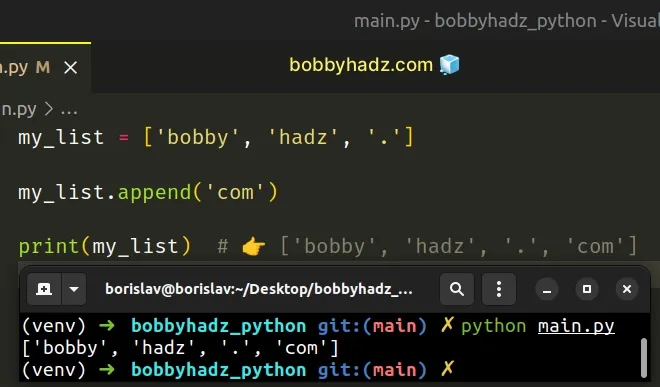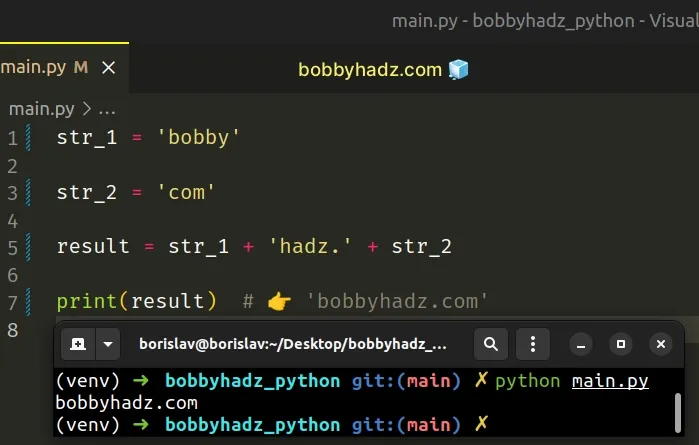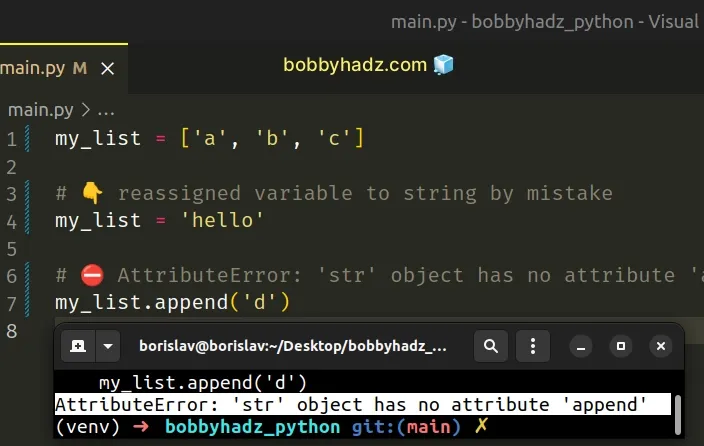AttributeError: 'str' object has no attribute 'append'
Last updated: Apr 8, 2024
Reading time·3 min

# AttributeError: 'str' object has no attribute 'append'
The Python "AttributeError: 'str' object has no attribute 'append'" occurs
when we try to call the append() method on a string (e.g. a list element at
specific index).
To solve the error, call the append method on the list or use the addition
(+) operator if concatenating strings.

Here is an example of how the error occurs.
a_str = 'bobbyhadz' # ⛔️ AttributeError: 'str' object has no attribute 'append' a_str.append('.com')
And here is another example of how the error occurs.
my_list = ['a', 'b', 'c'] # ⛔️ AttributeError: 'str' object has no attribute 'append' my_list[2].append('d')
We accessed the list element at index 2 before calling the append() method.
append on a string (a list item), instead of the list, which caused the error.# Make sure to call the append() method on a list
To solve the error, call append() on the list instead.
my_list = ['bobby', 'hadz', '.'] my_list.append('com') print(my_list) # 👉️ ['bobby', 'hadz', '.', 'com']

The list.append() method adds an item to the end of the list.
The method returns None as it mutates the original list.
# Use the addition (+) operator when concatenating strings
If you are trying to concatenate strings, use the addition operator (+) instead.
str_1 = 'bobby' str_2 = 'com' result = str_1 + 'hadz.' + str_2 print(result) # 👉️ 'bobbyhadz.com'

The addition (+) operator can be used to concatenate strings.
Alternatively, you can use a formatted string literal.
str_1 = 'bobby' str_2 = '.com' result = f'{str_1}hadz{str_2}' print(result) # 👉️ 'bobbyhadz.com'
f.Make sure to wrap expressions in curly braces - {expression}.
# Figure out where the variable got assigned a string
If you are trying to append an element to the end of a list, you have to figure
out how the value you are calling append() on got assigned a string.
my_list = ['a', 'b', 'c'] # 👇️ Reassigned the variable to a string by mistake my_list = 'hello' # ⛔️ AttributeError: 'str' object has no attribute 'append' my_list.append('d')

We set the my_list variable to a list initially, but it later got set to a
string which caused the error.
append() got assigned a string and correct the assignment.For example, calling the str.join() method on a list, joins the list into a string based on the provided separator.
a_list = ['bobby', 'hadz', 'com'] a_str = ','.join(a_list) print(a_str) # 👉️ bobby,hadz,com a_list = a_str.split(',') print(a_list) # 👉️ ['bobby', 'hadz', 'com'] a_list.append('new') print(a_list) # 👉️ ['bobby', 'hadz', 'com', 'new']
If you need to split the string into a list based on a separator, use the
str.split() method and then call list.append().
The str.split() method splits the string into a list of substrings using a delimiter.
print('bobby hadz com'.split(" ")) # 👉️ ['bobby', 'hadz', 'com'] print('bobby,hadz,com'.split(",")) # 👉️ ['bobby', 'hadz', 'com']
The method takes the following 2 parameters:
| Name | Description |
|---|---|
| separator | Split the string into substrings on each occurrence of the separator |
| maxsplit | At most maxsplit splits are done (optional) |
# How to debug your code
A good way to start debugging is to print(dir(your_object)) and see what
attributes a string has.
Here is an example of what printing the attributes of a string looks like.
my_string = 'hello world' # [ 'capitalize', 'casefold', 'center', 'count', 'encode', 'endswith', 'expandtabs', 'find', 'format', # 'format_map', 'index', 'isalnum', 'isalpha', 'isascii', 'isdecimal', 'isdigit', 'isidentifier', # 'islower', 'isnumeric', 'isprintable', 'isspace', 'istitle', 'isupper', 'join', 'ljust', 'lower', # 'lstrip', 'maketrans', 'partition', 'removeprefix', 'removesuffix', 'replace', 'rfind', 'rindex', # 'rjust', 'rpartition', 'rsplit', 'rstrip', 'split', 'splitlines', 'startswith', 'strip', 'swapcase', # 'title', 'translate', 'upper', 'zfill'] print(dir(my_string))
If you pass a class to the dir() function, it returns a list of names of the class's attributes and recursively of the attributes of its bases.
Since append() is not a method implemented by strings, the error is caused.
If the error persists, follow the instructions in my AttributeError: 'str' object has no attribute 'X in Python article.
# Additional Resources
You can learn more about the related topics by checking out the following tutorials:

